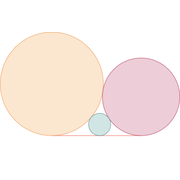tkz-euclide examples
Sangakus
Sangaku 1
[PDF] [TEX]
View TeX code
\documentclass[border=10]{standalone}
\usepackage{tkz-euclide}
\begin{document}
\begin{tikzpicture}[scale = 1.75]
\tkzDefPoint(0,0){B}
\tkzDefPoint(0,8){A}
\tkzDefSquare(A,B) \tkzGetPoints{C}{D}
\tkzDrawPolygon(A,...,D)
\tkzClipPolygon(A,...,D)
\tkzDefMidPoint(D,A)\tkzGetPoint{F}
\tkzDefMidPoint(C,B)\tkzGetPoint{E}
\tkzDefMidPoint(A,C)\tkzGetPoint{Q}
\tkzFillPolygon[color = green](A,B,C,D)
\tkzDrawCircle[fill = orange](B,A)
\tkzDrawCircle[fill = purple](E,B)
\tkzDefLine[tangent from =B](F,A)
\tkzInterLL(F,tkzSecondPointResult)(C,D)
\tkzInterLL(A,tkzPointResult)(F,E)
\tkzDrawCircle[fill = yellow](tkzPointResult,Q)
\tkzDefPointBy[projection= onto B--A](tkzPointResult)
\tkzDrawCircle[fill = blue!50!black](tkzPointResult,A)
\end{tikzpicture}
\end{document}
Sangaku 2
[PDF] [TEX]
View TeX code
\documentclass{standalone}
\usepackage{tkz-euclide}
\begin{document}
\begin{tikzpicture}[scale = 1.5]
\tkzInit[xmax = 8,ymax=8] \tkzClip
\tkzDefPoint(0,0){B} \tkzDefPoint(8,0){C} \tkzDefPoint(0,8){A} \tkzDefPoint(8,8){D}
\tkzDefSquare(B,C) \tkzGetPoints{D}{A}
\tkzDrawPolygon(B,C,D,A)
\tkzClipPolygon(A,B,C,D)
\tkzFillPolygon[color = blue!50!black](A,B,C,D)
\tkzDefTriangle[equilateral](B,C) \tkzGetPoint{M}
\tkzFillPolygon[color = purple](B,C,M)
\tkzInterLL(D,M)(A,B) \tkzGetPoint{N}
\tkzDefPointBy[rotation=center N angle -60](D)
\tkzGetPoint{L}
\tkzDefLine[bisector](C,B,M) \tkzGetPoint{x}
\tkzDefLine[bisector](N,L,B) \tkzGetPoint{y}
\tkzInterLL(L,y)(B,x) \tkzGetPoint{H}
\tkzDefLine[bisector](M,C,D) \tkzGetPoint{u}
\tkzDefLine[bisector](L,D,C) \tkzGetPoint{v}
\tkzDefPointBy[projection=onto C--B](H) \tkzGetPoint{I}
\tkzFillPolygon[color = orange,opacity = .5](D,N,L)
\tkzFillCircle[color = yellow](H,I)
\tkzInterLL(C,u)(D,v) \tkzGetPoint{K}
\tkzDefPointBy[projection=onto C--D](K) \tkzGetPoint{J}
\tkzDefPointBy[projection=onto B--C](M) \tkzGetPoint{E}
\tkzFillCircle[color = yellow](K,J)
\end{tikzpicture}
\end{document}
Sangaku 3
[PDF] [TEX]
View TeX code
\documentclass{standalone}
\usepackage{tkz-euclide}
\makeatletter
\def\threecircles(#1,#2)(#3,#4)(#5,#6,#7,#8){\begingroup
\tkzDefPoint(0,#2){#1}
\tkzDefPoint(0,0){#6}
\tkzDefPoint(1,0){tkz@x}
\tkzDefPoint(0,-#4){tkz@p}
\tkzDefPoint(-#2,0){tkz@i}
\tkzDefPoint(-#2,-#2){tkz@s}
\tkzDefMidPoint(A,tkz@p)
\tkzInterLC(E,tkz@x)(tkzPointResult,A)
\ifdim #2 pt > #4 pt
\tkzDefPointsBy[symmetry= center tkzFirstPointResult](#6,tkz@p){#8,#3}
\else \tkzDefPointsBy[symmetry= center tkzSecondPointResult](#6,tkz@p){#8,#3}
\fi
\tkzDefShiftPoint[#8](#4,-#4){tkz@r}
\tkzInterLL(#1,#6)(tkz@i,tkz@r) \tkzGetPoint{tkz@e}
\tkzDefShiftPoint[#8](#4,0){tkz@m}
\tkzInterLL(#3,#8)(tkz@s,tkz@m) \tkzGetPoint{tkz@f}
\tkzInterCC(#1,tkz@e)(#3,tkz@f) \tkzGetPoints{#5'}{#5}
\tkzDefPointBy[projection=onto #6--#8](#5) \tkzGetPoint{#7}
\endgroup
}
\makeatother
\begin{document}
\begin{tikzpicture}[scale=1]
\pgfmathsetmacro{\a}{4} \pgfmathsetmacro{\b}{3}
\threecircles(A,4)(B,3)(C,E,G,F)
\tkzDrawSegment[color = red](E,F)
\tkzDrawCircle[orange,fill=orange!20](A,E)
\tkzDrawCircle[purple,fill=purple!20](B,F)
\tkzDrawCircle[teal,fill=teal!20](C,G)
\end{tikzpicture}
\end{document}


